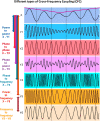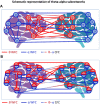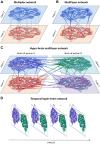Neural Synchrony and Network Dynamics in Social Interaction: A Hyper-Brain Cell Assembly Hypothesis
- PMID: 35572007
- PMCID: PMC9101304
- DOI: 10.3389/fnhum.2022.848026
Neural Synchrony and Network Dynamics in Social Interaction: A Hyper-Brain Cell Assembly Hypothesis
Abstract
Mounting neurophysiological evidence suggests that interpersonal interaction relies on continual communication between cell assemblies within interacting brains and continual adjustments of these neuronal dynamic states between the brains. In this Hypothesis and Theory article, a Hyper-Brain Cell Assembly Hypothesis is suggested on the basis of a conceptual review of neural synchrony and network dynamics and their roles in emerging cell assemblies within the interacting brains. The proposed hypothesis states that such cell assemblies can emerge not only within, but also between the interacting brains. More precisely, the hyper-brain cell assembly encompasses and integrates oscillatory activity within and between brains, and represents a common hyper-brain unit, which has a certain relation to social behavior and interaction. Hyper-brain modules or communities, comprising nodes across two or several brains, are considered as one of the possible representations of the hypothesized hyper-brain cell assemblies, which can also have a multidimensional or multilayer structure. It is concluded that the neuronal dynamics during interpersonal interaction is brain-wide, i.e., it is based on common neuronal activity of several brains or, more generally, of the coupled physiological systems including brains.
Keywords: graph-theoretic approach; hyper-brain network dynamics; multiplex and multilayer networks; neural synchrony; social interaction; within- and cross-frequency coupling.
Copyright © 2022 Müller.
Conflict of interest statement
The author declares that the research was conducted in the absence of any commercial or financial relationships that could be construed as a potential conflict of interest.
Figures








Similar articles
-
Hyper-brain hyper-frequency network topology dynamics when playing guitar in quartet.Front Hum Neurosci. 2024 Jun 11;18:1416667. doi: 10.3389/fnhum.2024.1416667. eCollection 2024. Front Hum Neurosci. 2024. PMID: 38919882 Free PMC article.
-
Interactive brains, social minds: Neural and physiological mechanisms of interpersonal action coordination.Neurosci Biobehav Rev. 2021 Sep;128:661-677. doi: 10.1016/j.neubiorev.2021.07.017. Epub 2021 Jul 14. Neurosci Biobehav Rev. 2021. PMID: 34273378 Review.
-
Dynamic Orchestration of Brains and Instruments During Free Guitar Improvisation.Front Integr Neurosci. 2019 Sep 4;13:50. doi: 10.3389/fnint.2019.00050. eCollection 2019. Front Integr Neurosci. 2019. PMID: 31551723 Free PMC article.
-
Brain functional connectivity and the pathophysiology of schizophrenia.Psychiatriki. 2014 Apr-Jun;25(2):91-4. Psychiatriki. 2014. PMID: 25035177 English, Greek, Modern.
-
Synchrony Across Brains.Annu Rev Psychol. 2025 Jan;76(1):883-911. doi: 10.1146/annurev-psych-080123-101149. Epub 2024 Dec 3. Annu Rev Psychol. 2025. PMID: 39441884 Review.
Cited by
-
The topology of interpersonal neural network in weak social ties.Sci Rep. 2024 Feb 29;14(1):4961. doi: 10.1038/s41598-024-55495-7. Sci Rep. 2024. PMID: 38418895 Free PMC article.
-
Interpersonal synchrony when singing in a choir.Front Psychol. 2023 Jan 11;13:1087517. doi: 10.3389/fpsyg.2022.1087517. eCollection 2022. Front Psychol. 2023. PMID: 36710769 Free PMC article. Review.
-
Intra- and inter-brain coupling and activity dynamics during improvisational music therapy with a person with dementia: an explorative EEG-hyperscanning single case study.Front Psychol. 2023 Sep 29;14:1155732. doi: 10.3389/fpsyg.2023.1155732. eCollection 2023. Front Psychol. 2023. PMID: 37842703 Free PMC article.
-
Hyper-brain hyper-frequency network topology dynamics when playing guitar in quartet.Front Hum Neurosci. 2024 Jun 11;18:1416667. doi: 10.3389/fnhum.2024.1416667. eCollection 2024. Front Hum Neurosci. 2024. PMID: 38919882 Free PMC article.
-
Healing synchrony? potential benefits of interpersonal synchrony for chronic pain management.Front Pain Res (Lausanne). 2025 Feb 5;6:1463321. doi: 10.3389/fpain.2025.1463321. eCollection 2025. Front Pain Res (Lausanne). 2025. PMID: 39974312 Free PMC article.
References
LinkOut - more resources
Full Text Sources

